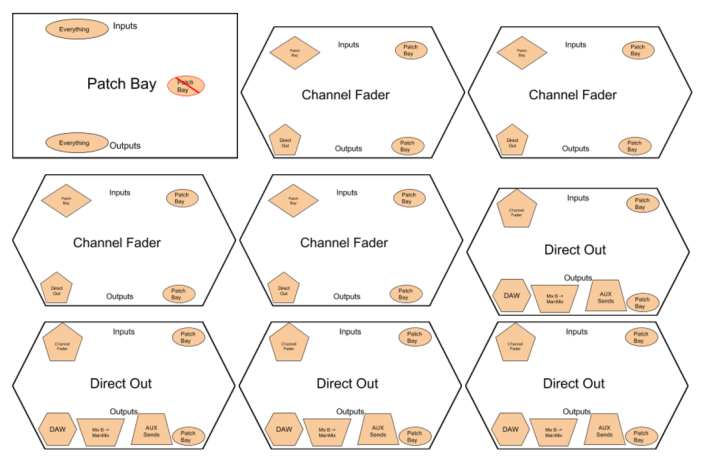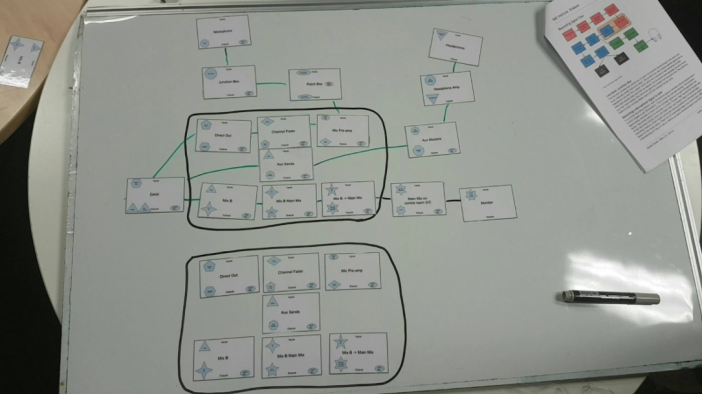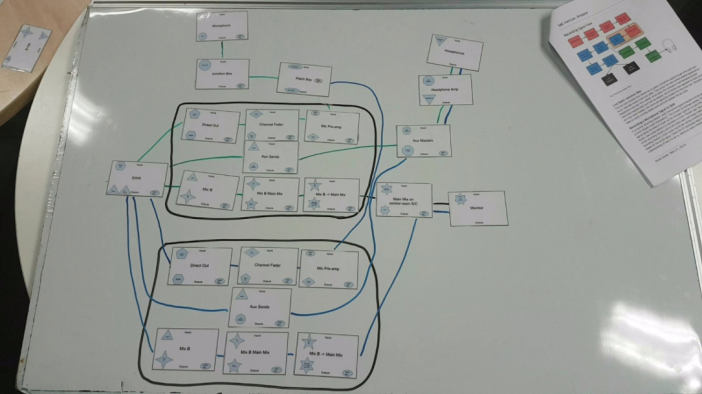As with the development of any game, ‘Flow’ underwent periodic Testing in order to adapt and refine the design of the game based on feedback and observation. However, unlike many of the projects undertaken before in Studio units, ‘Flow’ was not subjected to what you would call a traditional testing plan. With such a unique concept and compressed development life-cycle, we were forced to improvise in our approach to testing. What we came up with was something quite different to previous projects, and actually served a greater purpose than merely testing.
When we first handed over our initial prototype in Week 6 to the Programmers, we found that they struggled to understand the basic concepts of Signal Flow behind the game (or application). They didn’t have the earlier Studio access we had through Ash, and although we attempted to walk them through the processes involved, it quickly became clear that we required a middle tool to help bridge the gap in their knowledge base. We needed something physical that could be used to walk them through Signal Flow step by step, but also resembled the prototype we had provided to them. Primarily conceived by Noah, and tested by the entire Design Team, we came up with a system of Visual Aids that would later come to be know as ‘Flominoes‘.

A portmanteau of ‘Flow’ and Dominoes, ‘Flominoes’ are a series of tile-cards we created to represent each of the Nodes that make up every piece of equipment used in a typical Studio. Initially they were simply titled cards, used in iteration with the Signal Flow handbook provided to us by ash, that we could use to show on paper to the Programmers the path of audio in a Signal Flow loop, governed by the rules that each Node had to abide by. However, as development progresses these Flominoes went through a number of iterations that would eventually lead to them becoming a side-project that would grab the attention of the Client.
In its current state, Flominoes has gone through 5 and half major iterations, with each new version serving as more refined and accurate revision of Signal Flow represented on paper. Although Noah took the lead in the development of Flominoes, each Designer took part in testing at least one iteration of the tool. I for one tested the second iteration of Flominoes, running through Signal Flow level examples in an attempt to discover any potential deficiencies. Minor confusion was discovered in determining which Nodes could connect to one-another, an issue that would be addressed in subsequent iterations by the inclusion of symbols for easy recognition of Nodes and the clear separation between inputs and outputs.
With this tool in hand, it became far easier to bring the Programmers up to speed on Signal Flow functioned on paper, and allowed us to translate a design of a Signal Flow loop on paper into a Unity design with much more relative ease. Using a White-board or even the Floor (later iterations had string links between Nodes), an entire level for ‘Flow’ could be laid out and reassembled with very little difficulty. Changes could be made on the fly, with potential problems sometimes able to be anticipated before any work was done in Unity. Levels could be troubleshooted with Flominoes and redesigned by hand. Nodes could be dropped in and taken out, and channels became far easier to visualise when they could be physically separated into groups of linked cards.
EXAMPLE OF FLOMINOES IN PRACTISE: Level 2
For Level 2 in ‘Flow’, the design layout consisted of one Microphone, however there are two different channel groups, one of which consists of a broken ‘Mix B to Main Mix button, pre-setup when the level loads. The objective of the Player is to determine which grouping works and then complete the signal path normally.

This layout in Flominoes shows the layout of the Signal Flow as it exists when level 2 begins. It is then up to the Player in ‘Flow’ to correct the situation by identifying the broken Node.

In the image shown above, the solution to level 2 is laid out, with both channels utilised and the links between Nodes colour-coded based on their channel. Broken down, the solution is for Players to utilise the additional channel to route around the broken Node. With Flominoes, we can visually identify where each Node is, what it is connected to, what it can connect to, what channel it is a part of, and at what stage in the Signal Flow it is used. With each of these elements easily identifiable at a glance, we were able to troubleshoot each level quickly and effectively, allowing the design of each stage to rapidly iterate.
In further testing, the Patch-bay, which was by far the most troublesome and complex Node during development, was much easier to understand and interact with thanks to Flominoes. Armed with this, the design of several later levels (8, 9 & 10) were re-engineered to address faults related to how Signal Flow was handled by the ‘DirectOut’ and the ‘Master Mix B’. With these issues identified on paper, considerable time and effort was likely saved further down the line in Unity. Issues regarding the number of inputs and outputs available to each Node were also identified and resolved using Flominoes.
While it was never originally intended to be, Flominoes actually turned out to be a rather interesting side effect of the development of ‘Flow’. In many ways it turned out as the physical version of ‘Flow’, one that can interacted with by hand and stepped through in rather the same fashion, although without the visual feedback present in ‘Flow’. In another way, it turned out as a potential teaching tool, one that Arkshay and other Audio Staff members have expressed an interest in taking further. Like with ‘Flow’ itself, it too has the potential to be turned into a commercial product.
It also has the very real potential to function as an early trimester teaching aid, one that students being introduced to Signal Flow for the first time could greatly benefit from. Not only is it simple to produce and easy to pick up and understand, its very nature of development makes it an ideal companion piece to ‘Flow’ as a tool for practising Signal Flow. Whether or not the idea of Flominoes is taken forward from here, the potential remains regardless.